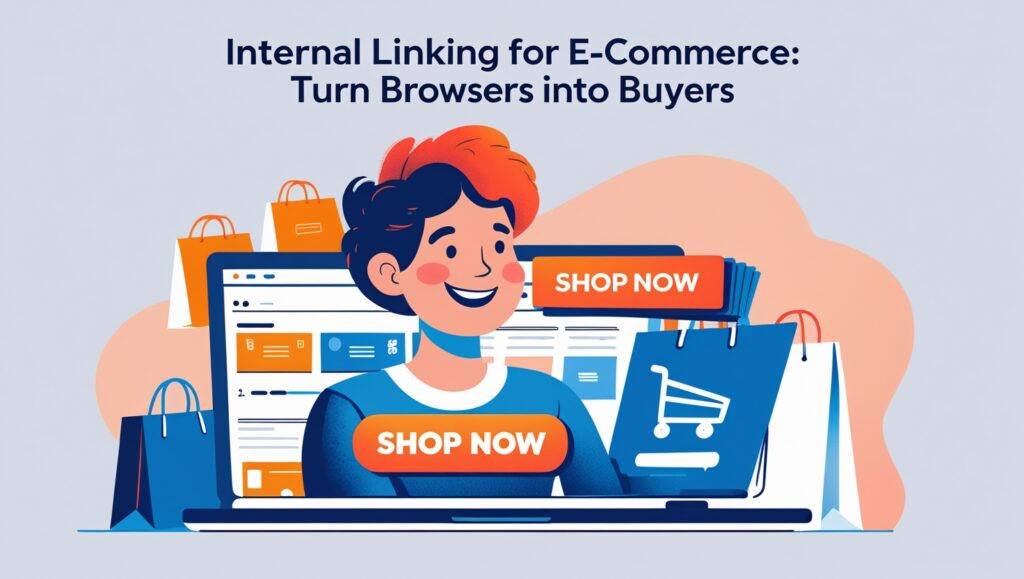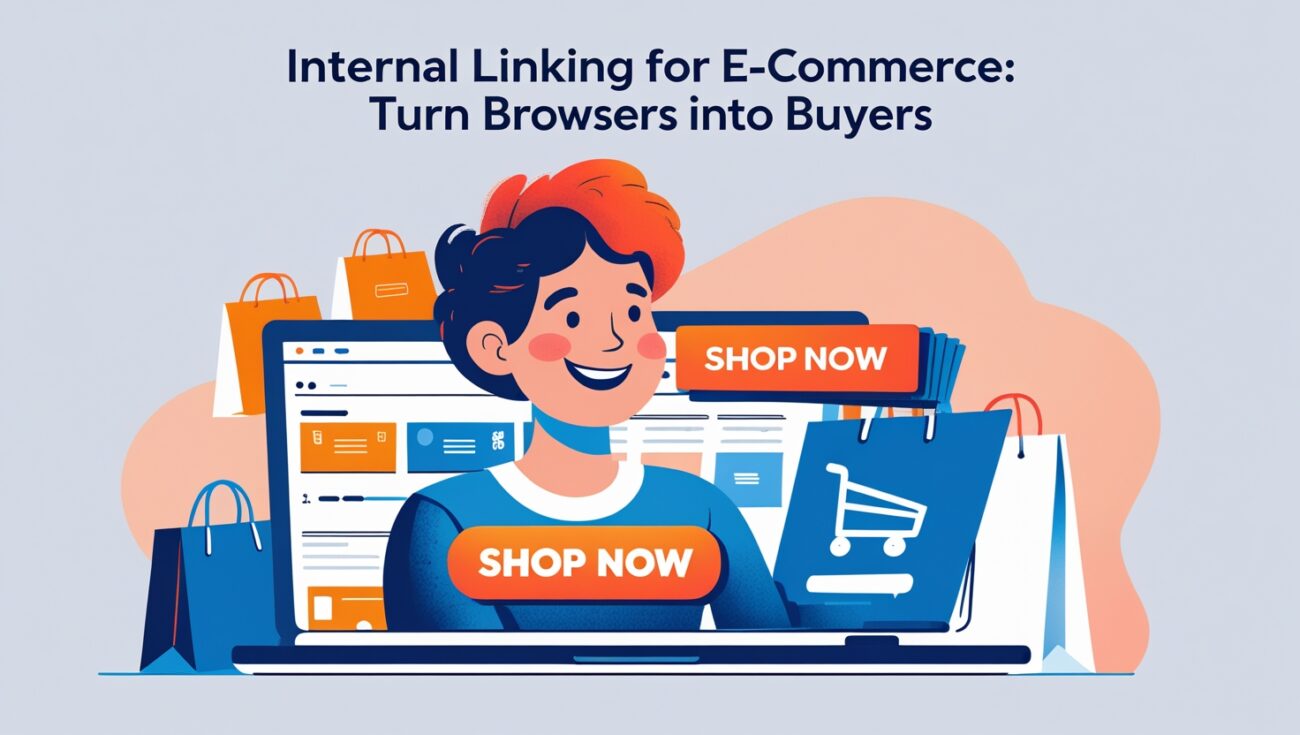Internal Linking for E-commerce: Turn Browsers Into Buyers
As an e-commerce store owner, your ultimate goal is to turn website visitors into paying customers. You can drive traffic through various means – SEO, social media, paid ads – but what happens once they land on your site? For years, I focused solely on getting more eyeballs on my product pages, but I wasn’t paying enough attention to the journey those browsers took within my store.

Table of Contents
I discovered that a strategic internal linking strategy is the secret to guiding visitors down the sales funnel, increasing product discovery, and ultimately, boosting your conversion rates. If you’re ready to stop relying on traffic alone and start turning more browsers into buyers, this guide is for you.
The E-commerce Internal Linking Opportunity
Unlike a blog where the goal is often to keep users reading, an e-commerce site has a clear conversion objective: a sale. Internal links are the pathways you create to guide visitors towards making a purchase.
- The Goal: To seamlessly direct visitors from informational content (like blog posts or category pages) to your product pages, and between related products, creating a smooth and intuitive shopping experience.
- The “Online Sales Assistant” Analogy: Think of your internal links as a helpful sales assistant in a physical store, guiding customers to related items, answering questions, and ultimately leading them to the checkout counter.
Key Internal Linking Strategies for E-commerce
Strategy #1: Link from Blog Content to Product Pages
If you have a blog that educates your audience about your products or their uses, make sure to strategically link to relevant product pages within your blog content.
- Example: If you sell coffee makers and have a blog post titled “The Ultimate Guide to Brewing the Perfect Cup,” naturally link to specific coffee maker product pages when you mention different types or features. Anchor text like “our best pour-over coffee maker” or “shop our automatic drip machines” can be highly effective.
Strategy #2: Link Between Related Products
Make it easy for customers to discover other items they might be interested in by linking between related products.
- Example: On a product page for a specific camera lens, include links to compatible camera bodies, filters, or tripods in the product description or in a “You Might Also Like” section. Use anchor text like “compatible camera bodies” or “explore our range of camera tripods.”
Strategy #3: Link from Category Pages to Subcategories and Products
Ensure your category pages are well-linked to relevant subcategories and individual product pages. This helps users navigate your product catalog easily and improves the crawlability of your deeper product pages.
- Example: On a “Women’s Shoes” category page, link prominently to subcategories like “Sneakers,” “Boots,” and “Sandals,” as well as to popular product listings.
Strategy #4: Utilize Product Recommendation Widgets (with Internal Links)
Many e-commerce platforms and plugins offer product recommendation widgets that automatically suggest related items to shoppers. Ensure these widgets are using internal links to other product pages within your store.
Strategy #5: Link to Informational Pages from Product Pages
Sometimes, a customer might have questions before making a purchase. Link from your product pages to helpful informational content like size guides, material explanations, or FAQs. This builds trust and reduces friction in the buying process.
The Tool That Streamlines E-commerce Internal Linking
Manually implementing and managing all these internal links on a large e-commerce store can be incredibly time-consuming. That’s where internal linking automation becomes a game-changer. A good tool can analyze your product catalog and content, suggesting relevant linking opportunities to boost product discovery and sales. [Ready to transform your e-commerce site into a high-converting machine? Discover how Linkbot can help you optimize your internal links.
Conclusion: Guide Your Visitors to Purchase
Internal linking is not just an SEO tactic for e-commerce websites; it’s a powerful sales strategy. By strategically guiding your browsers through your online store, you can enhance their shopping experience, increase product visibility, and ultimately turn more visitors into happy, paying customers. [Start implementing these e-commerce internal linking best practices today and watch your sales grow.
My journey taught me that a major mistake is seeing SEO as a mystery. By implementing a smart, corrective approach to my website, I made the mental shift from being a spectator to an active participant in my website’s success. This simple realization took the overwhelm out of SEO and turned it into a series of logical, manageable steps that I could control.
The long-term, compounding effect of fixing these mistakes is what makes it so powerful. Each time you add a thoughtful, relevant link, you are not just performing a task; you are building your website’s authority, one link at a time. These small, consistent improvements add up to a significant competitive advantage over the long term, making your website an increasingly powerful asset.
I can say from personal experience that there is a special kind of satisfaction that comes from seeing a direct correlation between a new link and a ranking boost. It’s the feeling of taking a tangled mess and organizing it into a clean, logical network. The result is a website that just feels better to navigate, for both users and the people managing it.
A clean internal link profile also has a huge impact on your website’s overall trustworthiness and authority. When a user or a search engine bot lands on your page and sees a clear network of interconnected, relevant articles, it signals that you are a serious, comprehensive resource on the topic. This kind of professional organization is exactly what Google looks for.
The most important part of this foundational skill is building a consistent habit of linking. It’s not about a single audit and then forgetting about it. A good website is a living thing, and it needs regular maintenance to ensure your internal links stay clean, which is a key part of long-term SEO success.
I felt like I was finally in the driver’s seat of my SEO. For years, I had relied on external factors, which felt like I was giving up control of my SEO destiny. But by mastering a simple task like building my internal links, I was proactively building my site’s authority from the inside out, on my own terms, which was an empowering and exciting feeling.
By implementing a strategy that serves both SEO and conversions, you are also directly addressing Google’s E-E-A-T framework. You are demonstrating expertise by creating topical clusters, you are showing authority by linking from strong pages, and you are providing a better user experience, which is a key part of what Google looks for in a trustworthy website.
I’ll never forget the first time I applied my new internal link strategy to a page that was struggling to rank, and it shot up in the search results almost overnight. This was my “aha” moment. I realized that a strategic, well-placed link from a high-authority page was far more powerful than I ever thought possible.
One of the greatest benefits I got from using an automated tool to manage my link profile was the “to-do” list it provided. Instead of being overwhelmed by the sheer size of my website, the tool gave me a prioritized, actionable list of fixes to make. It transformed a monumental, frustrating task into a series of manageable steps that I could tackle in just minutes.
It’s crucial to understand the difference between a simple, generic link and one that’s part of a strategic, mapped plan. A simple link is a one-off connection. A link that’s part of a plan is a purposeful part of a larger network, designed to pass authority and guide a user. The latter is far more powerful.
Ultimately, mastering internal linking is a simple but powerful strategy that transforms a website’s foundation. It’s a low-cost, high-impact fix that can instantly improve your site’s health and SEO performance. It’s the kind of foundational SEO work that every website owner should prioritize.
My final piece of advice is to not be intimidated. Don’t worry about the high cost of manual labor; just focus on making your website a better place for your readers. You will be amazed at the progress you make and the results you can achieve.

